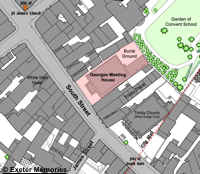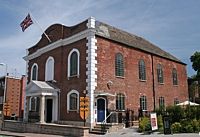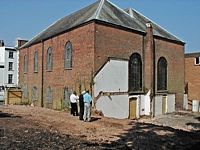
Georges Meeting House, South Street
Page updated 19th February 2014
 J D Wetherspoon are particularly noted for taking over redundant buildings, and converting them into pubs with a restaurant. In particular, they have turned several chapels across the country in to eateries, while retaining many of the internal features of the building. George's Meeting House is one such conversion, which has adapted a fine building, that had lost its way, into a thriving and popular restaurant.
J D Wetherspoon are particularly noted for taking over redundant buildings, and converting them into pubs with a restaurant. In particular, they have turned several chapels across the country in to eateries, while retaining many of the internal features of the building. George's Meeting House is one such conversion, which has adapted a fine building, that had lost its way, into a thriving and popular restaurant.
Early Presbyterians grew out of the 16th Century Protestant Reformation. The congregation were the 'church', while the place of worship was the 'meeting house'. In 1687, the Presbyterians of Exeter occupied a converted house in James Street, on the opposite side of South Street, which they named James's Meeting House, after King James II. When George's Meeting House was opened, the old meeting house in James Street was converted back into a house, to be eventually demolished in the 1960s by the city council.
George's Meeting House is a fine example of an 18th Century Unitarian Chapel. Founded in 1760, the coronation year of George III, and consequently, named George's Meeting House, the building has a striking façade on South Street.
Many of the wealthy merchant families of Exeter were 'so called' dissidents, who found the doctrine of the Trinity in the established church, too restricting for their taste, and preferred their simpler form of worship. Successful men wanted to speak to God in their own way, and they had the money to finance their own church. As a consequence, they were snubbed by the official church.
Local families
Jenkins in his History of Exeter wrote of the congregation of George's Meeting House "it has a large and genteel congregation belonging to it", which sums up the merchant class who worshipped there. An enthusiastic supporter in the early years was Sir John Baring, woollen merchants and banker. Another worthy member of the congregation in the early years of the 19th Century, was "Iron Sam" Kingdon, who ran a foundry in Waterbeer Street—he was born in 1779, and was baptised there, and became the first Mayor of Exeter from a dissenters background. The polymath, Sir John Bowring was also intimately involved with the church in the 19th Century. In 1873, E B Stephens, the creator of the Deerstalker in Northenhay Park, produced a marble bust of Sir John, for George's Meeting House. It can now be found in the Devon and Exeter institution.
The funds to build the new meeting house were raised by the sale of the old house in James Street, £400 was borrowed from a fund. The Kennaway family, woollen merchants and later wine importers also made a substantial donation towards the building work. Many in the congregation also subscribed to the project. It is suggested that £2,500 to £3,000 was raised, a huge amount for the time.
The building
The Meeting House is a two storey chapel constructed of the same locally produced brick, (probably the workhouse brickworks off Polsloe Road) that can be found in Dix's Field and Bedford Circus, with quoins of Portland stone. The portico is of a classical style portico of Tuscan columns, with a stone architrave, surmounted by a shallow pitched roof. There is a fine stone swept parapet over a modillion cornice, running above the windows. The hip roof is of slate.
There are five windows on the front, each with a stone architrave. There is one each side of the portico and three across the first floor—the centre window is blocked. When originally constructed, the building was on a very tight site, with buildings on each side. Despite this, the sides have four windows on each floor. The lower windows are brick segmental headed, while the upper are brick round headed.
The interior, is a simple rectangular space, with square, fluted, Ionic piers around three sides, supporting a narrow gallery. There is a plain, flat, plaster ceiling, that was designed to allow the resident preacher to be seen. The 18th Century carved pulpit, carved with drapery, was imported from their earlier meeting house on the corner of Palace Street and South Street. There are Ionic columns lining three sides supporting an oak panelled gallery. The vestry was added in 1781.
According to John Bowring, the meeting house had a marble tablet, in the vestry, surrounded by iron rails and covered with flowers of wild convolvulus. It was inscribed "Mr James Pierce's tomb". James Pierce, was an early 18th Century preacher who had crossed swords with the 'bigoted Church of England clergyman of St Leonard's'. After Pierce died, in 1726, the clergyman had refused the tablet to be placed over his grave, when he was buried in St Leonard's Churchyard. The tablet was placed in the Mint, and moved to George's Meeting House in the 19th Century.
In the centre of the church was a large, brass chandelier, suspended on a twisted rod of iron, on which SS, the initials of Sarah Stokes, were fashioned in gilded work, that could be read both forwards and backwards. Over a late 17th Century clock, over the western gallery, there was a golden sun emerging, or setting. Opposite the clock was a gilded Scythe of Death, a timely reminder to the pious that their time on earth was only too short.
The acoustics of the church proved to be difficult, and in August 1808, a committee was formed to consider changes. Between June and December 1809, the ceiling was lowered by three feet, at a cost of £201 18s 1d, reducing the volume of the space by a twelfth.
The church went into decline in the 19th Century, caused by a series of ministerial crises, and a loss of the merchant class to the established church, to fulfill their political ambitions.
Although the Dissenters burial yard in Magdalen Street was founded in 1741, Georges Meeting House had its own small burial ground at the rear. It quickly became inadequate, and many chose to be buried in the main burial yard, including members of the Bowring and Kennaway families.
End of service
The congregation declined during the 20th-century, and in 1983 the building became disused, and was sold in 1987, to become an antique centre. Later, as the Global Village, it was used to retail furniture and artifacts from around the world.
J D Wetherspoon purchased the old church and opened their second pub in Exeter on 16 January 2005. It was the first Wetherspoons, and also the first pub in Exeter to not allow smoking. Their conversion has preserved many of the old meeting house's features and saved a fine building from further dereliction. It is Grade 1 listed on 29 January 1953.
Sources: Biography of John Bowring, History of Exeter by Alexander Jenkins, J D Wetherspoon website, Non Conformity in Exeter 1650-1875 by Allan Brockett, and British Listed Buildings (English Heritage).
Photos from 2004 by Tony Mchale
│ Top of Page │









